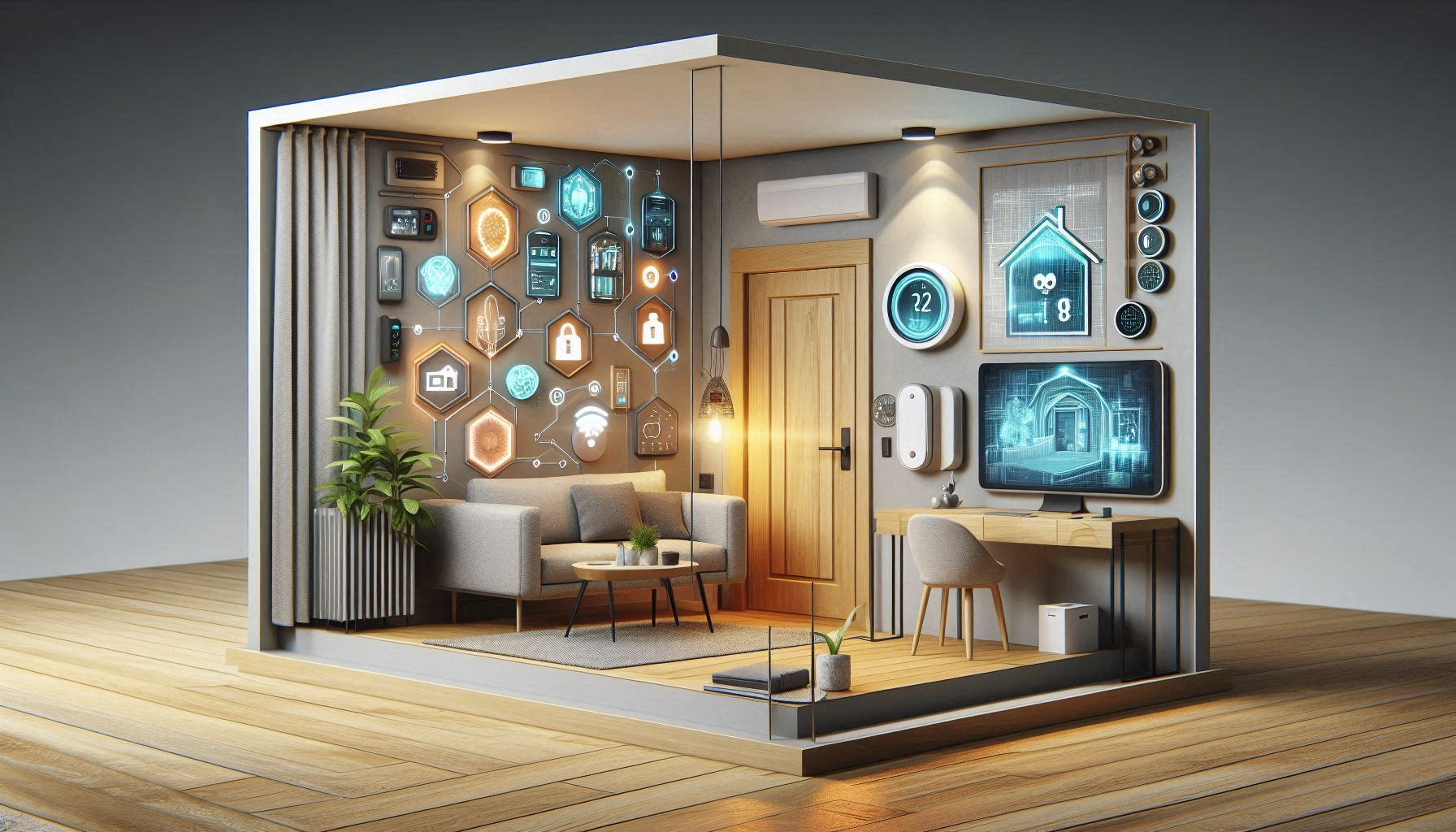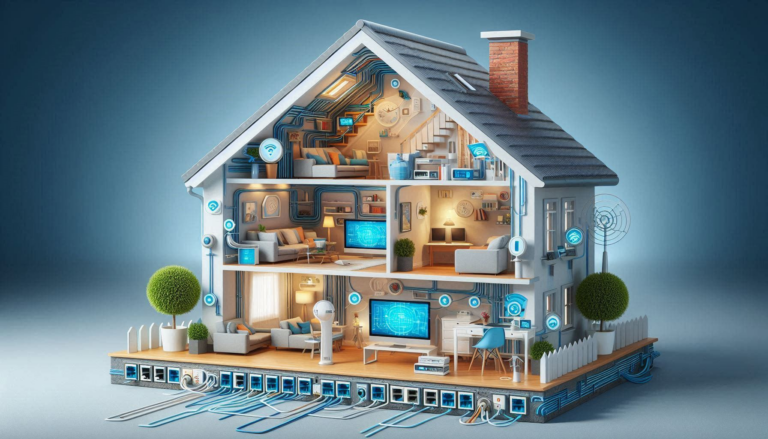Redesign my Smart Home with Thread Devices
If you’re new to the world of smart homes, or you’ve delved head first into the rabbit hole, you might have come across terms like “Matter” and “Thread.” These are not just buzzwords; they represent the next big leap in smart home technology. I thought it was a bout time I have a look at what Matter products are on the market and see what it would cost to upgrade my smart home. Before I do though, for those that may think I’m talking gibberish, let’s dive into what they are, how they work, and the exciting products that use them.
An Introduction to Matter over Thread
What is Matter?
Matter is a universal smart home standard developed by the Connectivity Standards Alliance (CSA), which includes big names like Apple, Google, Amazon, and Samsung. The goal of Matter is to ensure that smart home devices from different brands work seamlessly together. Imagine controlling your smart lights, thermostat, and security cameras all from a single app, regardless of the manufacturer. That’s the promise of Matter.
What is Thread?
Thread is a networking protocol designed specifically for smart home devices. Unlike traditional Wi-Fi or Bluetooth, Thread creates a low-power, reliable mesh network. This means that devices can communicate directly with each other, not just through a central hub or router. This mesh network enhances the stability and range of your smart home setup.
How Does Matter Over Thread Work?
When you combine Matter with Thread, you get a powerful duo. Matter provides the universal language for devices to communicate, while Thread offers the robust network to support that communication. Here’s how it works:
- Device Communication: Matter ensures that all your devices speak the same language, making it easier to set up and control them.
- Mesh Networking: Thread creates a mesh network where each device acts as a node, extending the network’s range and reliability.
- Local Control: Matter over Thread allows for local control of devices, meaning they can operate even if your internet goes down.
Products Using Matter Over Thread
Several products already support Matter over Thread, and the list is growing. Here are some examples:
- Smart Lights: Brands like Nanoleaf and Philips Hue have started integrating Matter over Thread into their smart lighting solutions.
- Thermostats: The Google Nest Thermostat is a great example of a device that benefits from the reliability of Thread and the universality of Matter.
- Smart Locks: Companies like Yale and Schlage are incorporating Matter over Thread into their smart locks, ensuring they work seamlessly with other devices in your home.
Devices That Can Control Matter Over Thread
To control these Matter over Thread devices, you’ll need a compatible controller. Fortunately, many popular smart home platforms support Matter:
- Amazon Alexa: Use your Echo devices to control your Matter-enabled smart home.
- Google Home: The Google Nest Hub and Nest Mini are excellent controllers for Matter devices.
- Apple HomeKit: With an iPhone, iPad, or HomePod, you can easily manage your Matter over Thread devices.
- Samsung SmartThings: Samsung’s SmartThings platform also supports Matter, giving you another option for control.
Smart Home Upgrade
Now that we have an idea of what Matter and Thread are, let’s dive into my plans for upgrading my smart home. Buckle up, because this is going to be a fun ride!
Heating
First up, heating. Our home’s heating system is about as smart as a rock right now. But that’s about to change! I recently watched Paul Hibbert’s latest YouTube video where he talked about the upcoming Tado X range of smart thermostats, set to be available in November. Since Tado’s website is still playing hard to get with information, I’m relying on Paul’s video transcript to guide me through this.
Product Overview
The Tado X range of radiator thermostats and boiler controllers are designed for efficient home heating management. They require minimal setup and are easy to use right out of the box. You can use any Matter-supported smart home platform, such as Apple HomeKit, Google Home, Home Assistant, or Amazon Alexa, without needing the Tado app or an internet connection.
Key Features:
- Advanced Functionality: Supports OpenTherm, allowing the boiler to react to weather changes, and geofencing, which adjusts heating based on your location.
- Automation: Some features, like automatic heating adjustments when leaving the house or detecting open windows, require a subscription. However, reminders for these actions are free.
- Quiet Operation: The thermostatic radiator valves (TRVs) are quieter than other smart TRVs on the market.
- Child Lock: Prevents children from changing the temperature on the TRVs themselves, allowing control only via the app.
Installation:
- The installation process is straightforward, but if you’re not comfortable with wiring, it might be worth getting an electrician involved. Anyone competent should be able to install the boiler controller by following the step-by-step instructions in the Tado app.
Compatibility:
- The new Tado X products are not compatible with previous Tado models due to the switch to Thread-based communication.
Overall, the Tado X range offers a premium feel and solid build quality, making it a highly recommended choice for smart home heating solutions.
Pricing
I’ve not been able to find pricing information for the Boiler Controller or the TRVs, which isn’t surprising as the products haven’t been released un the UK yet. I am hoping to be able to get prices in November when they are launched though.
Lighting Up My Smart Home: A Bright Idea
Alright, folks, let’s talk lighting. Currently, my home is a mishmash of Philips Hue Zigbee and Tuya Smart Life Wi-Fi bulbs. It’s like a United Nations of smart lighting, and frankly, it’s a bit of a mess. The goal? Move everything to one platform that doesn’t rely on Wi-Fi. Because, let’s be honest, there’s nothing worse than your lights going on strike because the Wi-Fi decided to take a coffee break.
The Wi-Fi Woes
Living in a rented home means I don’t want to mess with the light switches. So, smart bulbs it is! Philips Hue bulbs have been reliable, but finding Zigbee versions in local shops is like hunting for a unicorn. If I’m ordering online, why not explore other manufacturers?
Enter Nanoleaf
One such manufacturer is Nanoleaf. I was gifted a set of Nanoleaf Lines, which you might have seen if you’ve been on a video call with me. They’ve been impressive, only breaking when I changed the Wi-Fi name and had to reset them.
Since my Nanoleaf Lines can act as a border router for other Nanoleaf products, I decided to check out their online store. I wasn’t expecting much, having seen their Matter Thread bulbs on Amazon for £20 each. But then, I stumbled upon something interesting. They sell bulbs designed purely for Apple Home, working on Bluetooth and Thread, for a jaw-dropping £3.60 each (down from £17.99 for some reason). So, for the 18 E27 and B22 bulbs I need, that’s £64.80 instead of £323.82. Bargain!
The GU10 Dilemma
Unfortunately, I don’t have the same cheap option for the 11 GU10 bulbs I need. Replacing my existing Tuya Wi-Fi bulbs with Nanoleaf Matter Thread ones would cost £149.97. I can’t find any other reputable suppliers, so it looks like I’m stuck with these for now. But hey, I’ve saved £259.02 overall by switching from Matter and Thread to Bluetooth and Thread bulbs. Win! The kitchen and hall lights will have to wait, though, as I don’t think Mrs. Jim will be thrilled about spending £150 on 12 smart bulbs.
Smart Locks: The Pricey Frontier
Now, onto smart locks. I suspect this will be the most expensive part. SwitchBot makes a device for the inside of your door, but Mrs. Jim would definitely not like that. So, I’m looking for something compatible with our UPVC multi-point locking doors.
The Netatmo Option
I found the Netatmo Smart Door Lock, which replaces the Euro cylinder in our current multipoint door lock. The price is a bit shocking, considering it’s not motorised and doesn’t support Apple Home Key, only Apple HomeKit.
The Yale Conundrum
I was hoping for a solution from Yale. Their L1 Conexis Smart Locks look like normal UPVC multi-lock door handles and connect to a Wi-Fi bridge for smart features. They’re more expensive than Netatmo but still lack direct Apple Home Key integration. The Wi-Fi bridge has little information about HomeKit compatibility, so I’m a bit confused.
Living in the UK means we often have to wait a bit longer for some of these fancy technologies to reach our shores from reputable brands. Unfortunately, this seems to be as close as I can get for now. Maybe, just maybe, someone will soon come up with a product that works with multi-point doors and Apple Home Key. Fingers crossed!
Conclusion
Overall, it seems there’s been a big push on the heating and lighting side of Thread, but not enough for smart locks (at least in the UK) for my liking. I’ll definitely be having a natter with Mrs. Jim about getting my hands on some of those Nanoleaf bulbs in the coming weeks. If I manage to snag some, I’ll be sure to write a review.
When it comes to heating, I really want to replace all our radiator valves with smart TRVs, but I’ll have to wait until Tado releases more pricing information. I’ll also need to figure out what’s needed to swap out the valves on our radiator to normal TRVs first. Good thing I know a plumber!
Smart locks don’t seem to be happening here in the UK at the moment, so that idea will have to be put on hold for a little while.
What do you think of my lighting plans? Have you found a multi-point capable smart door lock in the UK? Id love to hear your thoughts. Let me know in the comments below or on the social post that brought you here!






